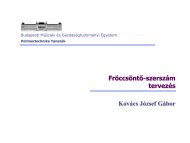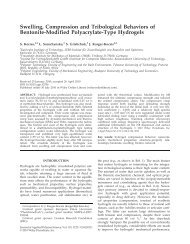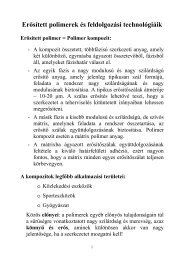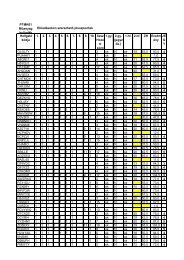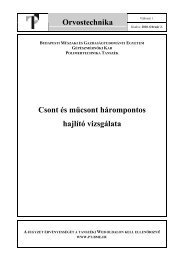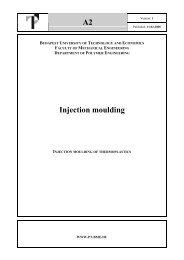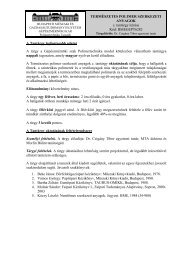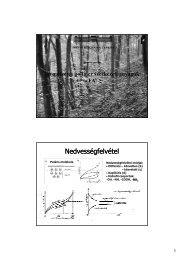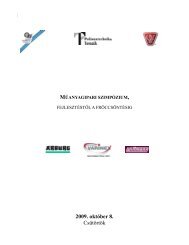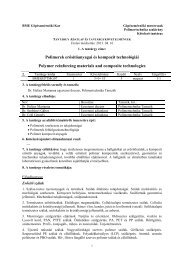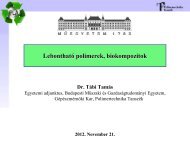Composites from Bast Fibres-Prospects and Potential in the ...
Composites from Bast Fibres-Prospects and Potential in the ...
Composites from Bast Fibres-Prospects and Potential in the ...
Create successful ePaper yourself
Turn your PDF publications into a flip-book with our unique Google optimized e-Paper software.
This article was downloaded by: [CSIR Information Services]<br />
On: 04 October 2011, At: 08:25<br />
Publisher: Taylor & Francis<br />
Informa Ltd Registered <strong>in</strong> Engl<strong>and</strong> <strong>and</strong> Wales Registered Number: 1072954<br />
Registered office: Mortimer House, 37-41 Mortimer Street, London W1T 3JH,<br />
UK<br />
Journal of Natural Fibers<br />
Publication details, <strong>in</strong>clud<strong>in</strong>g <strong>in</strong>structions for<br />
authors <strong>and</strong> subscription <strong>in</strong>formation:<br />
http://www.t<strong>and</strong>fonl<strong>in</strong>e.com/loi/wjnf20<br />
<strong>Composites</strong> <strong>from</strong> <strong>Bast</strong> <strong>Fibres</strong>-<br />
<strong>Prospects</strong> <strong>and</strong> <strong>Potential</strong> <strong>in</strong> <strong>the</strong><br />
Chang<strong>in</strong>g Market Environment<br />
Rajesh D. An<strong>and</strong>jiwala a b & Sunsh<strong>in</strong>e Blouw a<br />
a CSIR Materials Science <strong>and</strong> Manufactur<strong>in</strong>g, <strong>Fibres</strong><br />
<strong>and</strong> Textiles Competence Area, PO Box 1124, Port<br />
Elizabeth, 6000, South Africa<br />
b Department of Textile Science, University of Port<br />
Elizabeth, PO Box 1600, Port Elizabeth, 6000, South<br />
Africa<br />
Available onl<strong>in</strong>e: 12 Oct 2008<br />
To cite this article: Rajesh D. An<strong>and</strong>jiwala & Sunsh<strong>in</strong>e Blouw (2007): <strong>Composites</strong> <strong>from</strong><br />
<strong>Bast</strong> <strong>Fibres</strong>-<strong>Prospects</strong> <strong>and</strong> <strong>Potential</strong> <strong>in</strong> <strong>the</strong> Chang<strong>in</strong>g Market Environment, Journal of<br />
Natural Fibers, 4:2, 91-109<br />
To l<strong>in</strong>k to this article: http://dx.doi.org/10.1300/J395v04n02_07<br />
PLEASE SCROLL DOWN FOR ARTICLE<br />
Full terms <strong>and</strong> conditions of use: http://www.t<strong>and</strong>fonl<strong>in</strong>e.com/page/terms<strong>and</strong>-conditions<br />
This article may be used for research, teach<strong>in</strong>g, <strong>and</strong> private study purposes.<br />
Any substantial or systematic reproduction, redistribution, resell<strong>in</strong>g, loan,<br />
sub-licens<strong>in</strong>g, systematic supply, or distribution <strong>in</strong> any form to anyone is<br />
expressly forbidden.<br />
The publisher does not give any warranty express or implied or make any<br />
representation that <strong>the</strong> contents will be complete or accurate or up to<br />
date. The accuracy of any <strong>in</strong>structions, formulae, <strong>and</strong> drug doses should be
Downloaded by [CSIR Information Services] at 08:25 04 October 2011<br />
<strong>in</strong>dependently verified with primary sources. The publisher shall not be liable<br />
for any loss, actions, claims, proceed<strong>in</strong>gs, dem<strong>and</strong>, or costs or damages<br />
whatsoever or howsoever caused aris<strong>in</strong>g directly or <strong>in</strong>directly <strong>in</strong> connection<br />
with or aris<strong>in</strong>g out of <strong>the</strong> use of this material.
Downloaded by [CSIR Information Services] at 08:25 04 October 2011<br />
<strong>Composites</strong> <strong>from</strong> <strong>Bast</strong> <strong>Fibres</strong>–<br />
<strong>Prospects</strong> <strong>and</strong> <strong>Potential</strong> <strong>in</strong> <strong>the</strong> Chang<strong>in</strong>g<br />
Market Environment<br />
Rajesh D. An<strong>and</strong>jiwala<br />
Sunsh<strong>in</strong>e Blouw<br />
ABSTRACT. Composite materials re<strong>in</strong>forced with natural fibres, such<br />
as flax, hemp, kenaf <strong>and</strong> jute, are ga<strong>in</strong><strong>in</strong>g <strong>in</strong>creas<strong>in</strong>g importance <strong>in</strong> automotive,<br />
aerospace, packag<strong>in</strong>g <strong>and</strong> o<strong>the</strong>r <strong>in</strong>dustrial applications due to<br />
<strong>the</strong>ir lighter weight, competitive specific strength <strong>and</strong> stiffness, improved<br />
energy recovery, carbon dioxide sequestration, ease <strong>and</strong> flexibility<br />
of manufactur<strong>in</strong>g <strong>and</strong> environmental friendl<strong>in</strong>ess besides <strong>the</strong> benefit<br />
of <strong>the</strong> renewable resources of bast fibres. The market scenario for composite<br />
applications is chang<strong>in</strong>g due to <strong>the</strong> <strong>in</strong>troduction of newer biodegradable<br />
polymers, such as PLA syn<strong>the</strong>sized <strong>from</strong> corn, development<br />
of composite mak<strong>in</strong>g techniques <strong>and</strong> new str<strong>in</strong>gent environmental laws<br />
requir<strong>in</strong>g improved recyclability or biodegradability for <strong>in</strong>dustrial applications<br />
where stress bear<strong>in</strong>g capacities <strong>and</strong> micro-mechanical failures<br />
dictate serviceability. <strong>Bast</strong> fibre re<strong>in</strong>forced composites, made <strong>from</strong> biodegradable<br />
polymers, will have to compete with conventional composites<br />
<strong>in</strong> terms of <strong>the</strong>ir mechanical behaviour. Biocomposites, <strong>in</strong> which<br />
natural fibres, such as kenaf, jute, flax, hemp, sisal, corn stalk, bagasse or<br />
even grass are embedded <strong>in</strong> a biodegradable matrix, made as bioplastics<br />
<strong>from</strong> soybean, corn <strong>and</strong> sugar, have opened-up new possibilities for<br />
Rajesh D. An<strong>and</strong>jiwala (E-mail: ran<strong>and</strong>i@csir.co.za) is Chief Researcher, <strong>and</strong><br />
Sunsh<strong>in</strong>e Blouw (E-mail: sblouw@csir.co.za) is Research Group Leader–Fibre Process<strong>in</strong>g;<br />
both are affiliated with CSIR Materials Science <strong>and</strong> Manufactur<strong>in</strong>g, <strong>Fibres</strong><br />
<strong>and</strong> Textiles Competence Area, PO Box 1124, Port Elizabeth 6000, South Africa.<br />
Rajesh D. An<strong>and</strong>jiwala is also affiliated with Faculty of Science, Department of<br />
Textile Science, University of Port Elizabeth, PO Box 1600, Port Elizabeth 6000, South<br />
Africa (E-mail: Rajesh.An<strong>and</strong>jiwala@nmmu.ac.za).<br />
Journal of Natural Fibers, Vol. 4(2) 2007<br />
Available onl<strong>in</strong>e at http://jnf.haworthpress.com<br />
© 2007 by The Haworth Press, Inc. All rights reserved.<br />
doi:10.1300/J395v04n02_07 91
Downloaded by [CSIR Information Services] at 08:25 04 October 2011<br />
92 JOURNAL OF NATURAL FIBERS<br />
applications <strong>in</strong> automotive <strong>and</strong> build<strong>in</strong>g products. Obviously, new approaches<br />
to research <strong>and</strong> development will be required to improve <strong>the</strong>ir<br />
mechanical properties, such as tensile, bend<strong>in</strong>g <strong>and</strong> impact resistance<br />
to match <strong>the</strong>ir performance <strong>and</strong> commercial competitiveness aga<strong>in</strong>st<br />
petroleum based products. The research community has to look at <strong>the</strong><br />
various possibilities of comb<strong>in</strong><strong>in</strong>g natural fibres, such as sisal, flax,<br />
hemp <strong>and</strong> jute with polymer matrices <strong>from</strong> non-renewable <strong>and</strong> renewable<br />
resources to develop cost effective biocomposites. This paper will<br />
review <strong>the</strong> newer products <strong>and</strong> techniques that can improve <strong>the</strong> properties<br />
of bast fibre based composites as well as potential structural<br />
<strong>and</strong> non-structural applications which can <strong>in</strong>crease <strong>the</strong>ir market share.<br />
doi:10.1300/J395v04n02_07 [Article copies available for a fee <strong>from</strong> The<br />
Haworth Document Delivery Service: 1-800-HAWORTH. E-mail address: Website: © 2007<br />
by The Haworth Press, Inc. All rights reserved.]<br />
KEYWORDS. Fibre-re<strong>in</strong>forced composite, biodegradable, natural fibres,<br />
bast fibres, hemp, flax, kenaf, particle boards, automotive components,<br />
biocomposites, <strong>the</strong>rmoset, <strong>the</strong>rmoplastic<br />
INTRODUCTION<br />
A composite material is a heterogeneous comb<strong>in</strong>ation of two or more<br />
different constituents (re<strong>in</strong>forc<strong>in</strong>g elements, fillers <strong>and</strong> b<strong>in</strong>ders), differ<strong>in</strong>g<br />
<strong>in</strong> form or composition on a macroscale. The comb<strong>in</strong>ation results <strong>in</strong><br />
a composite material that maximizes specific performance properties<br />
not atta<strong>in</strong>able <strong>in</strong> <strong>the</strong> <strong>in</strong>dividual constituents. The constituents do not dissolve<br />
or merge completely <strong>and</strong> <strong>the</strong>refore normally exhibit an <strong>in</strong>terface<br />
between one ano<strong>the</strong>r.<br />
The fierce competition <strong>in</strong> <strong>the</strong> fibre re<strong>in</strong>forced composites market has<br />
compelled <strong>the</strong> manufacturers to be <strong>in</strong>novative, adopt newer production<br />
techniques, utilize cheaper res<strong>in</strong>s <strong>and</strong> fillers while ma<strong>in</strong>ta<strong>in</strong><strong>in</strong>g performance<br />
<strong>in</strong> terms of strength, temperature resistance, fracture <strong>and</strong> resilience.<br />
Essentially new products are developed for exist<strong>in</strong>g <strong>and</strong> newer<br />
applications by utiliz<strong>in</strong>g different fillers <strong>and</strong> comb<strong>in</strong>ations of fillers <strong>and</strong><br />
re<strong>in</strong>forcements. Traditionally, most syn<strong>the</strong>tic fibres, such as carbon,<br />
E-glass, boron, aramid, <strong>and</strong> Kevlar, have been widely used as re<strong>in</strong>forc<strong>in</strong>g<br />
medium <strong>in</strong> composites. For example, commonly used res<strong>in</strong>s <strong>in</strong>clude<br />
polypropylene for automotive applications, such as air cleaner hous<strong>in</strong>gs,<br />
nylon for transmission gears, polyphenylene sulphide (PPS) for
Downloaded by [CSIR Information Services] at 08:25 04 October 2011<br />
Rajesh D. An<strong>and</strong>jiwala <strong>and</strong> Sunsh<strong>in</strong>e Blouw 93<br />
electrical components, polycarbonate (PC) for household applications,<br />
polyethylene, <strong>and</strong> polyethylene ethyl ketone (PEEK) for flexible circuit<br />
boards. Due to <strong>the</strong> <strong>in</strong>creased pressure <strong>from</strong> environmental activists<br />
<strong>and</strong> attendant str<strong>in</strong>gency of laws passed by most developed countries,<br />
<strong>the</strong> composite manufactur<strong>in</strong>g <strong>in</strong>dustry has to search for plant based natural<br />
fibre re<strong>in</strong>forcements, such as flax, hemp, jute, kenaf, sisal, henequen,<br />
p<strong>in</strong>eapple, <strong>and</strong> banana. Therefore, accelerated development efforts<br />
have taken place over <strong>the</strong> past two decades <strong>in</strong> <strong>the</strong> field of natural fibre<br />
based composites.<br />
The market for fibre-re<strong>in</strong>forced plastics has <strong>in</strong>creased <strong>in</strong> leaps <strong>and</strong><br />
bounds over <strong>the</strong> past four decades. Almost 1.0 billion kilograms of re<strong>in</strong>forced<br />
composites were produced worldwide <strong>in</strong> 2002 <strong>and</strong> <strong>the</strong> market<br />
is forecast to <strong>in</strong>crease by some 3.5% per annum, with <strong>the</strong> production<br />
reach<strong>in</strong>g about 1.2 billion kilograms, with a value of US$ 6.5 billion<br />
<strong>in</strong> 2007. Figure 1 shows <strong>the</strong> distribution of <strong>the</strong> market for fibre-re<strong>in</strong>forced<br />
composites accord<strong>in</strong>g to application (Bus<strong>in</strong>ess Communication Company,<br />
Inc., 2002).<br />
FIGURE 1. Distribution of fibre-re<strong>in</strong>forced composites by application (2002).<br />
Source: Bus<strong>in</strong>ess Communication Company, Inc., 2002.
Downloaded by [CSIR Information Services] at 08:25 04 October 2011<br />
94 JOURNAL OF NATURAL FIBERS<br />
Automotive, construction, mar<strong>in</strong>e <strong>and</strong> electronic applications account<br />
for <strong>the</strong> major proportion of composites. Thermoset composites<br />
account for about 62% of <strong>the</strong> total volume produced <strong>in</strong> 2002 <strong>and</strong> it is<br />
expected to dom<strong>in</strong>ate over fibre-re<strong>in</strong>forced <strong>the</strong>rmoplastic composites<br />
despite <strong>the</strong> popularity of <strong>the</strong> latter due to <strong>the</strong>ir recyclability. Long-fibre<br />
<strong>the</strong>rmoplastic composites <strong>and</strong> nanocomposites are likely to play an <strong>in</strong>creas<strong>in</strong>gly<br />
important role <strong>in</strong> <strong>the</strong> com<strong>in</strong>g years, as research <strong>and</strong> development<br />
will mature (Bus<strong>in</strong>ess Communications Company, Inc., 2002).<br />
To strike a balance between cost, quality, performance, environmental<br />
regulations <strong>and</strong> supply of natural fibres, such as, flax, hemp, jute,<br />
kenaf <strong>and</strong> sisal, a number of composite manufacturers are develop<strong>in</strong>g<br />
new facilities for utiliz<strong>in</strong>g alternative fibres (Karnani et al, 1997; Marsh,<br />
2003). To augment <strong>the</strong> resource driven approach <strong>and</strong> strategy for f<strong>in</strong>d<strong>in</strong>g<br />
new applications for <strong>the</strong> available natural fibres, <strong>the</strong> automotive<br />
<strong>in</strong>dustry has taken <strong>the</strong> leadership. The automotive sector requires reasonably<br />
durable materials which must biodegrade at <strong>the</strong> end of <strong>the</strong>ir<br />
service life. Re<strong>in</strong>forced composites made <strong>from</strong> l<strong>in</strong>go-cellulosic plant<br />
materials offer attractive opportunities because of <strong>the</strong>ir strength result<strong>in</strong>g<br />
<strong>from</strong> <strong>the</strong> strength of fibre bundles. The applications of such bast<br />
fibre re<strong>in</strong>forced composites <strong>in</strong> load bear<strong>in</strong>g components as opposed to<br />
conventional composites based on wood fibre may turn out to be one of<br />
<strong>the</strong> material revolutions of <strong>the</strong> twenty first century (Rowell et al., 1998).<br />
The advantages <strong>and</strong> disadvantages of natural fibre re<strong>in</strong>forced composites<br />
may be listed as follows:<br />
Advantages<br />
Reduction <strong>in</strong> density of products by 10 to 30% <strong>in</strong> comparison to<br />
conventional metallic parts.<br />
Acceptable specific strength, toughness <strong>and</strong> stiffness <strong>in</strong> comparison<br />
with glass fibre re<strong>in</strong>forced composites.<br />
Ease of shap<strong>in</strong>g <strong>in</strong>to complex shapes <strong>in</strong> a s<strong>in</strong>gle manufactur<strong>in</strong>g<br />
process.<br />
Reduced tool wear.<br />
Most <strong>the</strong>rmoplastic-based natural fibre-re<strong>in</strong>forced composites are<br />
recyclable <strong>and</strong> <strong>the</strong>y are earth friendly as a susta<strong>in</strong>able renewable<br />
raw material is utilized.<br />
Lower energy consumption <strong>from</strong> fibre grow<strong>in</strong>g to f<strong>in</strong>ished composites,<br />
<strong>in</strong> comparison to syn<strong>the</strong>tic <strong>and</strong> glass fibre based composites.<br />
For example, very high <strong>the</strong>rmal energy is required dur<strong>in</strong>g<br />
sp<strong>in</strong>n<strong>in</strong>g of syn<strong>the</strong>tic fibres.
Downloaded by [CSIR Information Services] at 08:25 04 October 2011<br />
<strong>Bast</strong> fibres are CO 2 neutral as oxygen is emitted back <strong>in</strong>to <strong>the</strong> environment<br />
dur<strong>in</strong>g degradation. The possibility of <strong>the</strong>rmal recycl<strong>in</strong>g<br />
<strong>in</strong> contrast to <strong>the</strong> combustion process for glass fibres make <strong>the</strong>m<br />
environmentally friendly.<br />
The manufactur<strong>in</strong>g processes are relatively safe when compared<br />
with glass fibre based re<strong>in</strong>forced composites. The glass fibres emit<br />
small airborne glass particles dur<strong>in</strong>g manufactur<strong>in</strong>g, thus caus<strong>in</strong>g<br />
<strong>the</strong> problem of occupational safety.<br />
Reduced dermal <strong>and</strong> respiratory irritation.<br />
Possibility of recycl<strong>in</strong>g <strong>the</strong> cutt<strong>in</strong>gs <strong>and</strong> wastage produced dur<strong>in</strong>g<br />
manufactur<strong>in</strong>g <strong>and</strong> mould<strong>in</strong>g.<br />
No emission of toxic fumes when subjected to heat <strong>and</strong> dur<strong>in</strong>g <strong>in</strong>c<strong>in</strong>eration.<br />
The production of natural fibres can be started with a low capital<br />
<strong>in</strong>vestment <strong>and</strong> with a lower cost, thus offer<strong>in</strong>g great potential to<br />
poor <strong>and</strong> develop<strong>in</strong>g nations for <strong>the</strong> generation of employment.<br />
<strong>Bast</strong> fibres exhibit good <strong>the</strong>rmal <strong>and</strong> acoustic <strong>in</strong>sulation properties.<br />
Disadvantages<br />
Rajesh D. An<strong>and</strong>jiwala <strong>and</strong> Sunsh<strong>in</strong>e Blouw 95<br />
Lack of consistency of fibre quality, high level of variability <strong>in</strong> fibre<br />
properties depend<strong>in</strong>g upon source <strong>and</strong> cultivars.<br />
Preparation of fibre is labour <strong>in</strong>tensive <strong>and</strong> time consum<strong>in</strong>g.<br />
Poor compatibility between <strong>the</strong> fibres <strong>and</strong> matrix, which requires<br />
surface treatment of fibres.<br />
Lower impact strength of bast fibre re<strong>in</strong>forced composites.<br />
High moisture absorption, which br<strong>in</strong>gs about dimensional changes<br />
<strong>in</strong> composite materials.<br />
Poor fire resistance, which restricts applications where risk due<br />
to fire is possible. Fire retardants have to be bonded to <strong>the</strong> fibre cell<br />
wall to improve <strong>the</strong> fire resistance of <strong>the</strong> composites.<br />
The availability of suitable fibres is uncerta<strong>in</strong> <strong>and</strong> supply is ra<strong>the</strong>r<br />
irregular. The uncerta<strong>in</strong> of supply is sometimes <strong>in</strong>fluenced by<br />
national agricultural policy <strong>and</strong> politics.<br />
Low density of bast fibres can be disadvantageous dur<strong>in</strong>g composite<br />
process<strong>in</strong>g application because fibres tend to migrate to <strong>the</strong><br />
surface ra<strong>the</strong>r than gett<strong>in</strong>g mixed with <strong>the</strong> matrix.<br />
Fluctuation <strong>in</strong> price depend<strong>in</strong>g upon <strong>the</strong> global dem<strong>and</strong> <strong>and</strong> production.
Downloaded by [CSIR Information Services] at 08:25 04 October 2011<br />
96 JOURNAL OF NATURAL FIBERS<br />
Problem of stor<strong>in</strong>g raw material for extended time due to possibility<br />
of degradation, biological attack of fungi <strong>and</strong> mildew, loss <strong>in</strong><br />
colour, <strong>and</strong> foul odour development.<br />
Lower resistance to ultra violet radiation, which causes <strong>the</strong> structural<br />
degradation of <strong>the</strong> composites.<br />
FIBRES FOR COMPOSITES<br />
The compatibility between polymers, fibre surface, <strong>and</strong> composite<br />
manufactur<strong>in</strong>g processes employed will determ<strong>in</strong>e <strong>the</strong> properties of<br />
composite materials. Important natural plant materials used <strong>in</strong> composite<br />
materials is classified <strong>in</strong> Figure 2.<br />
Wood fibres have been traditionally utilized <strong>in</strong> some composite<br />
applications as <strong>the</strong>y are uniform, <strong>in</strong>expensive <strong>and</strong> abundant; never<strong>the</strong>less,<br />
<strong>the</strong>y are very short which limits <strong>the</strong>ir re<strong>in</strong>forc<strong>in</strong>g ability. <strong>Bast</strong> fibres<br />
alone account for some 4 million tons of global fibre production <strong>and</strong><br />
represent a vast <strong>and</strong> susta<strong>in</strong>able raw material source. O<strong>the</strong>r natural fibres<br />
<strong>from</strong> leaf (sisal, banana, palm, p<strong>in</strong>eapple) <strong>and</strong> seed (cotton, coir, kapok)<br />
of plants are also utilized as re<strong>in</strong>forcement <strong>in</strong> composite materials; however,<br />
<strong>the</strong>y are out of <strong>the</strong> scope of <strong>the</strong> present paper. The physical, mechanical<br />
<strong>and</strong> chemical properties of major bast fibres, as well as <strong>the</strong><br />
widely used E-glass fibre, are compared <strong>in</strong> Table 1.<br />
The bast consists of a woody core surrounded by a stem. The stem<br />
consists of a number of fibre bundles, each conta<strong>in</strong><strong>in</strong>g <strong>in</strong>dividual fibre<br />
cells or filament like fibres. Chemically, <strong>the</strong> fibres are made of cellulose<br />
<strong>and</strong> hemicellulose <strong>and</strong> <strong>the</strong>y are bonded toge<strong>the</strong>r by a matrix conta<strong>in</strong><strong>in</strong>g<br />
lign<strong>in</strong> or pect<strong>in</strong>. The pect<strong>in</strong> surrounds <strong>the</strong> bundle of fibres <strong>and</strong> bonds it<br />
to <strong>the</strong> stem. The pect<strong>in</strong> is removed dur<strong>in</strong>g <strong>the</strong> rett<strong>in</strong>g process which enables<br />
<strong>the</strong> separation of fibre bundles <strong>from</strong> <strong>the</strong> rest of <strong>the</strong> stem.<br />
From Table 1 it is evident that <strong>the</strong> density of glass fibres is higher<br />
than all <strong>the</strong> bast fibres. The tensile strength of all bast fibres is lower<br />
than that of glass fibre, never<strong>the</strong>less, <strong>the</strong> elastic modulus, E, of hemp<br />
<strong>and</strong> flax fibres is comparable to that of glass fibre. Due to <strong>the</strong> lower density<br />
of bast fibres, <strong>the</strong>ir specific strengths are comparable to that of glass<br />
fibre. The dimensional properties of bast fibres are highly variable due<br />
to <strong>the</strong>ir natural orig<strong>in</strong>, rett<strong>in</strong>g process <strong>and</strong> fibre separation techniques<br />
employed. The moisture absorption of bast fibres is far higher than<br />
that of glass fibre which is somewhat disadvantageous <strong>in</strong> certa<strong>in</strong> composite<br />
manufactur<strong>in</strong>g processes. Special pre-treatments are required to<br />
control <strong>the</strong> moisture dur<strong>in</strong>g <strong>the</strong> composite manufactur<strong>in</strong>g processes.
Downloaded by [CSIR Information Services] at 08:25 04 October 2011<br />
FIGURE 2. Natural re<strong>in</strong>forc<strong>in</strong>g medium for composites.<br />
97
Downloaded by [CSIR Information Services] at 08:25 04 October 2011<br />
98<br />
TABLE 1. Physical, mechanical <strong>and</strong> chemical properties of bast fibres (Source 2-5, Rowell, 1995).<br />
Properties Flax Hemp Jute Kenaf (<strong>Bast</strong>) E-Glass Fibre<br />
S<strong>in</strong>gle fibre length (mm)<br />
Range 10-70 7-55 2-5 1.4-5 <br />
Average 32 25 2.6<br />
Bundle fibre length (mm) 250-1200 1000-4000 1500-3600 1500-4000 <br />
Mean diameter (m) 19 25 20 21<br />
Density (g/cm3 ) 1.4 1.48 1.46 1.2 2.55<br />
Moisture absorption (%) 7 8 12 12 <br />
Tensile strength (N/m2 ) 800-1500 550-900 400-800 275-450 2400<br />
Young’s modulus, E (GPa) 60-80 70 10-30 73<br />
Specific E/density 26-46 47 7-21 29<br />
Elongation at break (%) 1.2-1.6 1.6 1.8 3<br />
Cellulose (%) 78.5 68.1 58-63 60.8 <br />
Hemi-cellulose (%) 9.2 15.1 21-24 20.3 <br />
Lign<strong>in</strong> (%) 8.5 10.6 12-14 11.0 <br />
Pect<strong>in</strong> (%) 2.3 3.6 # 3.2 <br />
Ash (%) 1.5 2.5 0.5 4.7 <br />
#No authoritative value available.<br />
Note: Properties of natural fibres vary <strong>and</strong> depend upon <strong>the</strong> fibre preparation, test specimen, test<strong>in</strong>g method, orig<strong>in</strong> of fibres, agricultural<br />
parameters, <strong>and</strong> so on.<br />
This table is compiled <strong>from</strong> various sources.
Downloaded by [CSIR Information Services] at 08:25 04 October 2011<br />
Rajesh D. An<strong>and</strong>jiwala <strong>and</strong> Sunsh<strong>in</strong>e Blouw 99<br />
COMPOSITE PROCESSES<br />
The applications of bast fibres <strong>in</strong> composites <strong>in</strong>clude particle boards,<br />
automotive components, electronic circuit boards, household appliances<br />
<strong>and</strong> packag<strong>in</strong>g products. Most of <strong>the</strong>se applications <strong>in</strong>volve<br />
compression mould<strong>in</strong>g technology <strong>in</strong> which usually medium to long<br />
bast fibres <strong>in</strong> <strong>the</strong> form of non-woven mat or felt are used. Compression<br />
mould<strong>in</strong>g was specifically developed with a view to replace<br />
metal components with composite parts. The mould<strong>in</strong>g process can be<br />
carried out with ei<strong>the</strong>r <strong>the</strong>rmosets or <strong>the</strong>rmoplastics. However, most applications<br />
today use <strong>the</strong>rmoset polymers <strong>and</strong> <strong>in</strong> fact, compression mould<strong>in</strong>g<br />
is <strong>the</strong> most common method of process<strong>in</strong>g <strong>the</strong>rmosets (El-Sheikh<br />
et al., 1997).<br />
As natural fibres do not possess <strong>the</strong>rmoform<strong>in</strong>g properties <strong>the</strong> addition<br />
of polymer as b<strong>in</strong>der is necessary. The composite can be formed by<br />
coat<strong>in</strong>g, impregnat<strong>in</strong>g or compound<strong>in</strong>g <strong>the</strong> bast fibres with polymer <strong>and</strong><br />
<strong>the</strong>n sett<strong>in</strong>g/cur<strong>in</strong>g <strong>the</strong> matrix to form a solid material which can be<br />
moulded <strong>in</strong>to <strong>the</strong> desired shape. The process employed is dependent<br />
upon <strong>the</strong> type <strong>and</strong> characteristics of <strong>the</strong> polymer. Thermoplastic polymers,<br />
such as polypropylene, polyester <strong>and</strong> <strong>the</strong>ir bi-components are<br />
used for <strong>the</strong>rmoform<strong>in</strong>g <strong>the</strong> natural fibres. In <strong>the</strong> <strong>the</strong>rmoset process, <strong>the</strong><br />
natural fibre mat or fabric is coated or impregnated with epoxy res<strong>in</strong>s or<br />
polyurethane. It is <strong>the</strong>n moulded <strong>in</strong>to <strong>the</strong> desired f<strong>in</strong>ished products. All<br />
bast fibres, such as flax, hemp, jute <strong>and</strong> kenaf, can be used to produce<br />
<strong>the</strong>rmoset or <strong>the</strong>rmoplastic moulded components us<strong>in</strong>g compression<br />
mould<strong>in</strong>g techniques.<br />
Injection mould<strong>in</strong>g is <strong>the</strong> process <strong>in</strong> which <strong>the</strong> polymer matrix is re<strong>in</strong>forced<br />
with short natural fibres <strong>in</strong> <strong>the</strong> desired proportion. A hot, molten<br />
polymer is <strong>in</strong>jected <strong>in</strong>to a cold mould. A screw apparatus, ei<strong>the</strong>r a s<strong>in</strong>gle<br />
or tw<strong>in</strong> screw type, is used to <strong>in</strong>ject <strong>the</strong> polymer <strong>in</strong>to <strong>the</strong> mould. After<br />
<strong>the</strong> mould cools <strong>and</strong> solidifies, it is opened <strong>and</strong> <strong>the</strong> part is ejected. The<br />
short bast fibres are compounded with a polymer, such as polypropylene,<br />
<strong>and</strong> <strong>the</strong>n also extruded <strong>in</strong>to granules for subsequent <strong>in</strong>jection<br />
mould<strong>in</strong>g (Karmaker <strong>and</strong> Youngquist, 1996).<br />
Pultrusion technology for mak<strong>in</strong>g bast fibre based composite is<br />
ga<strong>in</strong><strong>in</strong>g very wide acceptance <strong>the</strong>se days. <strong>Bast</strong> fibres can be easily<br />
converted <strong>in</strong>to str<strong>and</strong>s <strong>and</strong> cords due to <strong>the</strong>ir sp<strong>in</strong>nability. Pultrusion<br />
technology can utilize <strong>the</strong> thread-like material to form <strong>the</strong> re<strong>in</strong>forced<br />
composite. Pultrusion is a cont<strong>in</strong>uous process for manufactur<strong>in</strong>g composites<br />
that have a constant cross-sectional shape. The basic process usually<br />
<strong>in</strong>volves pull<strong>in</strong>g cont<strong>in</strong>uous fibres–re<strong>in</strong>forc<strong>in</strong>g material–through a
Downloaded by [CSIR Information Services] at 08:25 04 October 2011<br />
100 JOURNAL OF NATURAL FIBERS<br />
res<strong>in</strong> impregnation bath conta<strong>in</strong><strong>in</strong>g catalyst <strong>and</strong> <strong>the</strong>n <strong>in</strong>to pre-form<strong>in</strong>g<br />
fixtures where <strong>the</strong> section is partially pre-shaped <strong>and</strong> excess res<strong>in</strong> is<br />
removed. It is <strong>the</strong>n passed through a heated die, which determ<strong>in</strong>es <strong>the</strong><br />
sectional geometry <strong>and</strong> f<strong>in</strong>ish of <strong>the</strong> f<strong>in</strong>al product (Mittal <strong>and</strong> Biswas).<br />
The primary re<strong>in</strong>forcement <strong>in</strong> pultrusion is <strong>in</strong> <strong>the</strong> longitud<strong>in</strong>al fibre<br />
direction whereas <strong>in</strong> filament w<strong>in</strong>d<strong>in</strong>g it is <strong>in</strong> <strong>the</strong> hoop direction. These<br />
materials are generally used <strong>in</strong> structural applications. Commonly used<br />
re<strong>in</strong>forcements <strong>in</strong> pultrusion are glass, carbon <strong>and</strong> aramid fibres. The<br />
matrix material must cure quickly, not only because of <strong>the</strong> high speed of<br />
material production but also because it is a cont<strong>in</strong>uous process. The<br />
technology can be employed for develop<strong>in</strong>g high end structural composites<br />
<strong>from</strong> bast fibres as substitutes for man-made fibre based materials<br />
(Richardson <strong>and</strong> Zhang, 2001).<br />
OPPORTUNITIES FOR BAST FIBRES<br />
<strong>Bast</strong> fibre based composites may offer a profitable return if <strong>the</strong> selection<br />
of raw materials; both fibre grade <strong>and</strong> polymer, utilisation of <strong>the</strong> right<br />
manufactur<strong>in</strong>g technique <strong>in</strong> view of <strong>the</strong> end-use characteristics, <strong>and</strong> right<br />
strategy of value addition through performance improvement features are<br />
employed judiciously. The development of new markets by offer<strong>in</strong>g<br />
products with improved properties, <strong>and</strong> substitut<strong>in</strong>g <strong>the</strong> exist<strong>in</strong>g glass<br />
fibre based products by bast fibre based composite can offer opportunities.<br />
Major products <strong>from</strong> bast fibres are summarised here as follows:<br />
Particleboards <strong>and</strong> fibreboards (composite lumber)<br />
Automotive components<br />
Hous<strong>in</strong>g <strong>and</strong> <strong>in</strong>frastructure products<br />
Biocomposites<br />
Particleboards <strong>and</strong> Fibreboards<br />
Particle <strong>and</strong> fibreboards constitute major applications of bast fibre<br />
based composite materials. In conventional wood based boards, <strong>the</strong><br />
waste wood or wood chips mixed with saw dust are mixed with phenolic<br />
res<strong>in</strong>s <strong>and</strong> <strong>the</strong>n pressed between two hot plates. Subsequently <strong>the</strong>y<br />
are subjected to gr<strong>in</strong>d<strong>in</strong>g <strong>and</strong> polish<strong>in</strong>g for f<strong>in</strong>ished products. Low, medium<br />
<strong>and</strong> high density fibre boards are made depend<strong>in</strong>g upon <strong>the</strong><br />
end-use requirement. Hemp, flax, kenaf, ei<strong>the</strong>r by itself or with o<strong>the</strong>r<br />
cellulosic waste, such as wood chips <strong>and</strong> dust, are most widely used
Downloaded by [CSIR Information Services] at 08:25 04 October 2011<br />
Rajesh D. An<strong>and</strong>jiwala <strong>and</strong> Sunsh<strong>in</strong>e Blouw 101<br />
with <strong>the</strong> appropriate b<strong>in</strong>ders. Traditionally, isocynate <strong>and</strong> melam<strong>in</strong>e are<br />
<strong>the</strong> best <strong>and</strong> <strong>the</strong> most cost-effective b<strong>in</strong>ders for bast fibres <strong>and</strong> woody<br />
matters which provide adequate strength <strong>and</strong> performance for most exterior<br />
applications. S<strong>in</strong>ce isocynate releases no formaldehyde dur<strong>in</strong>g<br />
manufactur<strong>in</strong>g <strong>and</strong> use, which makes it safe. Considerable recent research<br />
on b<strong>in</strong>der, <strong>the</strong> use of <strong>in</strong>expensive core of bast as substrate <strong>and</strong> <strong>the</strong><br />
improved adhesion with substrate due to pre-treatments, has reduced<br />
<strong>the</strong> cost to make <strong>the</strong>m economically attractive <strong>and</strong> thus viable.<br />
However, such composite boards are susceptible to destruction due<br />
to fire <strong>and</strong> <strong>the</strong>refore <strong>the</strong>ir use can be limited particularly <strong>in</strong> public <strong>and</strong><br />
high-rise build<strong>in</strong>gs. The application of special fire retardant coat<strong>in</strong>gs is<br />
required to make <strong>the</strong>m non-ignitable. A number of studies have been reported<br />
<strong>in</strong> which fire retardant chemicals, m<strong>in</strong>eral particles as fillers<br />
<strong>and</strong> non-flammable b<strong>in</strong>ders are added dur<strong>in</strong>g <strong>the</strong> production process<br />
(Kozlowski et al., 1999). In this research, a three-layer non-flammable<br />
composite particle board, based on lignocellulosic particles <strong>and</strong> m<strong>in</strong>eral<br />
filler, was used with urea–formaldehyde res<strong>in</strong>, as a b<strong>in</strong>der (Kozlowsky<br />
et al., 1999). These authors have reported production technologies for<br />
mak<strong>in</strong>g such boards <strong>and</strong> have produced non-flammable boards with<br />
sufficient strength <strong>and</strong> durability. The technique can be used for raw<br />
materials, such as wooden particles, bast fibres <strong>and</strong> shives (Kozlowski<br />
et al, 1999). This research group fur<strong>the</strong>r developed fire resistant upholstery<br />
us<strong>in</strong>g non-woven fire-retardant flax. The non-woven used <strong>in</strong> <strong>the</strong><br />
composites plays <strong>the</strong> role of fire barrier which reduces <strong>the</strong> vulnerability<br />
of <strong>the</strong> fill<strong>in</strong>g material to <strong>the</strong> development <strong>and</strong> spread of fire (Kozlowski<br />
et al., 2004). In a recent study, encompass<strong>in</strong>g many applications, <strong>the</strong><br />
flame retardancy of biodegradable polymers <strong>and</strong> biocomposites was<br />
<strong>in</strong>vestigated. For comparison, flame retardant ligno-cellulosic fibre<br />
re<strong>in</strong>forced biocomposites were prepared us<strong>in</strong>g polypropylene (PP),<br />
polyurethane (PUR) <strong>and</strong> fully biodegradable starch matrices. The phosphorus<br />
additives <strong>in</strong> flame retardant polyurethane biocomposites compris<strong>in</strong>g<br />
waste bio-fillers <strong>and</strong> recycled polyol proved to be very effective<br />
because both <strong>the</strong> matrix <strong>and</strong> <strong>the</strong> filler components contribute towards<br />
<strong>the</strong> mechanism of flame retardancy (Matkó et al., 2005).<br />
In ano<strong>the</strong>r <strong>in</strong>terest<strong>in</strong>g study, it was reported that hemp fabric treated<br />
with flame retardants showed a high limit<strong>in</strong>g oxygen <strong>in</strong>dex <strong>and</strong> char<br />
yield which <strong>in</strong>dicated that <strong>the</strong> flame retardancy of treated hemp was<br />
improved (Xu et al., 2002).<br />
The use of alternative b<strong>in</strong>ders arises <strong>from</strong> <strong>the</strong> market dem<strong>and</strong> to reduce<br />
<strong>the</strong> cost of <strong>the</strong> product <strong>and</strong> comply with newer environment laws.<br />
Lign<strong>in</strong>, a natural b<strong>in</strong>der <strong>in</strong> plant materials, is also offer<strong>in</strong>g potential <strong>in</strong>
Downloaded by [CSIR Information Services] at 08:25 04 October 2011<br />
102 JOURNAL OF NATURAL FIBERS<br />
develop<strong>in</strong>g completely bio-based fibreboards. However, this approach<br />
has achieved limited success to date. O<strong>the</strong>r bio-based b<strong>in</strong>ders, such as<br />
soybeans based adhesives <strong>and</strong> res<strong>in</strong>s derived <strong>from</strong> natural source, are<br />
under study currently.<br />
The economic viability of bast fibre based particle <strong>and</strong> fibre board is<br />
yet not well established due to <strong>the</strong>ir cost of production. The raw material<br />
is relatively expensive <strong>in</strong> comparison to conventional wood based particleboards.<br />
The technical feasibility conducted by various researchers on<br />
<strong>the</strong> use of bast fibres, such as kenaf, hemp <strong>and</strong> flax, <strong>in</strong> furnish<strong>in</strong>g-based<br />
panel <strong>and</strong> particleboard applications <strong>in</strong>dicate that bast fibres can ei<strong>the</strong>r<br />
supplement or replace conventional wood, provided products are planned<br />
to exploit <strong>the</strong>ir special properties, such as strength <strong>and</strong> toughness (Marsh,<br />
2003; Lloyd <strong>and</strong> Seber, 1996).<br />
Automotive Components<br />
Automotive components offer unprecedented opportunities for bast<br />
fibres. Dur<strong>in</strong>g <strong>the</strong> past 10 years <strong>the</strong> use of natural fibre composites <strong>in</strong><br />
automotive <strong>in</strong>terior components has <strong>in</strong>creased <strong>in</strong> leaps <strong>and</strong> bounds. Due<br />
to <strong>the</strong> availability of different manufactur<strong>in</strong>g technologies <strong>and</strong> <strong>the</strong> proximity<br />
of raw materials <strong>in</strong> Europe, hemp <strong>and</strong> flax fibres are utilized <strong>in</strong><br />
such applications. Jute, grown <strong>in</strong> sub-tropical regions, such as India <strong>and</strong><br />
Bangladesh, <strong>and</strong> Kenaf <strong>in</strong> <strong>the</strong> United States are also nowadays utilized<br />
<strong>in</strong> automotive components. Decorticated bast fibres, such as flax, hemp,<br />
jute <strong>and</strong> kenaf, are particularly suitable as re<strong>in</strong>forcement for polymeric<br />
res<strong>in</strong>s, <strong>the</strong>rmoplastic <strong>and</strong> <strong>the</strong>rmoset composites, most prevalent <strong>in</strong> automotive<br />
components. The rapid <strong>in</strong>crease <strong>in</strong> bast fibre based composites<br />
<strong>in</strong> automotive <strong>in</strong>dustries is also attributed to <strong>the</strong> production of lighter<br />
<strong>and</strong> fuel efficient cars, <strong>the</strong> requirement for reduced air pollution <strong>and</strong> <strong>the</strong><br />
difficulty associated with recycl<strong>in</strong>g glass, carbon, <strong>and</strong> aramid fibre re<strong>in</strong>forced<br />
composites <strong>from</strong> polyester, epoxy <strong>and</strong> similar res<strong>in</strong>s, besides <strong>the</strong><br />
high level of energy expended <strong>in</strong> <strong>the</strong> entire value-addition cha<strong>in</strong>. One<br />
ton of natural bast fibres require only 12% of <strong>the</strong> energy required to<br />
produce <strong>the</strong> equivalent amount of glass fibres (Marsh, 2003).<br />
A logical beg<strong>in</strong>n<strong>in</strong>g should be to utilize easily available recyclable<br />
res<strong>in</strong>s, such as, polypropylene, polyolef<strong>in</strong>, polyethylene, polyamide<br />
<strong>and</strong> polyurethane, <strong>in</strong> comb<strong>in</strong>ations with biodegradable plant fibres.<br />
Thanks to high production, non-woven technologies that can provide<br />
non-woven mat or felt at relatively low price. The non-woven mat<br />
can be produced by <strong>the</strong> most prevalent needle-punch<strong>in</strong>g or air lay<strong>in</strong>g or<br />
hydroentanglement technology. The compression mould<strong>in</strong>g technology
Downloaded by [CSIR Information Services] at 08:25 04 October 2011<br />
Rajesh D. An<strong>and</strong>jiwala <strong>and</strong> Sunsh<strong>in</strong>e Blouw 103<br />
can be utilized with appropriate b<strong>in</strong>ders to make <strong>the</strong>rmoset or <strong>the</strong>rmoplastic<br />
composites. Non-woven mat <strong>from</strong> hemp fibres as re<strong>in</strong>forc<strong>in</strong>g<br />
medium <strong>in</strong> phenolic res<strong>in</strong> have been studied (Richardson <strong>and</strong> Zhang,<br />
2001). The <strong>in</strong>troduction of two layers of non-woven fabrics <strong>in</strong>to res<strong>in</strong><br />
improved <strong>the</strong> panel flexural strength <strong>from</strong> 11 MPa to 25 MPa <strong>and</strong><br />
stiffness by 23%. The impact resistance of phenolic res<strong>in</strong> without re<strong>in</strong>forcement<br />
is quite low due to its brittleness, <strong>the</strong> addition of hemp as re<strong>in</strong>forcement<br />
improved it markedly due to transfer of impact force <strong>from</strong><br />
matrix to fibres. The <strong>in</strong>troduction of bast fibre based mat <strong>in</strong> also reduces<br />
<strong>the</strong> number <strong>and</strong> size of voids formed due to cur<strong>in</strong>g of <strong>the</strong>rmoset attributed<br />
to <strong>the</strong> hydrophilicity of bast fibres which absorbs moisture<br />
produced by <strong>the</strong> cur<strong>in</strong>g (Richardson <strong>and</strong> Zhang, 2001).<br />
The applications of bast fibre re<strong>in</strong>forced composites <strong>in</strong> automobiles<br />
is so far limited to <strong>in</strong>terior items, such as door panels, <strong>in</strong>ner trim parts,<br />
parcel compartments, shelves, headl<strong>in</strong>ers, <strong>and</strong> roof l<strong>in</strong>ers, where conventional<br />
glass fibre <strong>and</strong> syn<strong>the</strong>tic fibre based composites far exceed <strong>the</strong><br />
strength requirements for such applications. This provides a great opportunity<br />
for bast fibres as more <strong>and</strong> more vehicle manufacturers are recognis<strong>in</strong>g<br />
<strong>the</strong>ir cost-benefit advantage <strong>and</strong> <strong>the</strong> need to comply with new<br />
recycl<strong>in</strong>g legislations.<br />
The major drawback of a bast fibre re<strong>in</strong>forced composite is its poor<br />
impact strength, although <strong>the</strong> properties of bast fibre re<strong>in</strong>forced composites<br />
<strong>from</strong> <strong>the</strong>rmoplastic <strong>and</strong> <strong>the</strong>rmosett<strong>in</strong>g res<strong>in</strong>s have proved to be<br />
adequate <strong>in</strong> non- <strong>and</strong> semi-structural applications, research aimed at improv<strong>in</strong>g<br />
<strong>the</strong>ir impact strength will be very useful for develop<strong>in</strong>g structural<br />
applications. This requires research on <strong>in</strong>terfacial properties to<br />
improve impact strength. Pre-treatment of bast fibres before <strong>the</strong> composite<br />
mak<strong>in</strong>g process is a key to improve <strong>in</strong>terlam<strong>in</strong>ar strength. For<br />
example, <strong>in</strong> a recent study a treatment of bast fibres with alkali <strong>and</strong> diluted<br />
res<strong>in</strong> improved adhesion between fibres <strong>and</strong> epoxy <strong>in</strong>terlam<strong>in</strong>ar<br />
strength almost by 100%. Recent <strong>in</strong>vention specifically overcomes past<br />
difficulties <strong>in</strong>volv<strong>in</strong>g compound<strong>in</strong>g <strong>and</strong> <strong>in</strong>jection mould<strong>in</strong>g of composite<br />
specimens with bast fibre re<strong>in</strong>forcements. In one form, ultrasonic energy<br />
is applied to decorticated bast fibres to cause fibrillation which<br />
improves <strong>the</strong>ir adhesion to polymer matrix (Krishnaswamy, US Patent<br />
No: 6767634, July 27, 2004).<br />
Hous<strong>in</strong>g <strong>and</strong> Infrastructure Products<br />
Hous<strong>in</strong>g <strong>and</strong> <strong>in</strong>frastructure applications require structural composite<br />
materials <strong>and</strong> <strong>the</strong> use of natural fibres based composites can play an
Downloaded by [CSIR Information Services] at 08:25 04 October 2011<br />
104 JOURNAL OF NATURAL FIBERS<br />
important role <strong>in</strong> this segment as new emerg<strong>in</strong>g materials. The construction<br />
<strong>in</strong>dustry accounts for almost 32% of <strong>the</strong> total dem<strong>and</strong> for re<strong>in</strong>forced<br />
composites today. It is important that better <strong>and</strong> affordable<br />
houses are built <strong>from</strong> “green” materials to reduce <strong>the</strong> impact of erosion<br />
of trees for ecological <strong>and</strong> climatic conditions. For twenty-first century<br />
affordable alternative materials for hous<strong>in</strong>g are needed <strong>and</strong> researchers<br />
are focused on biobased structural composite materials. The manufactur<strong>in</strong>g<br />
technologies lead<strong>in</strong>g to <strong>the</strong> hybridization of different constituents,<br />
such as fibre re<strong>in</strong>forced composite <strong>and</strong> biobased plastic, at structural<br />
levels can help (Drzal et al., 2001, Riedel <strong>and</strong> Nickel, 1999).<br />
Conventional fibre re<strong>in</strong>forced plastic, whe<strong>the</strong>r <strong>from</strong> natural or petroleum<br />
orig<strong>in</strong>, are not suitable for load bear<strong>in</strong>g hous<strong>in</strong>g applications due<br />
to <strong>the</strong>ir low strength, low bend<strong>in</strong>g resistance, low <strong>the</strong>rmal stability <strong>and</strong><br />
poor dimensional stability. Polyester is <strong>the</strong> most widely used material <strong>in</strong><br />
composites for <strong>the</strong> hous<strong>in</strong>g <strong>in</strong>dustry. Natural fibres <strong>and</strong> polyester fibre<br />
based non-woven mats <strong>in</strong> <strong>the</strong> proportions of 90 <strong>and</strong> 10%, respectively,<br />
have been tried as re<strong>in</strong>forcement <strong>in</strong> unsaturated polyester res<strong>in</strong>. Blends<br />
of unsaturated polyester res<strong>in</strong> <strong>and</strong> vegetable oils were also tried as<br />
<strong>the</strong> matrix <strong>in</strong> a 30% by volume fraction of <strong>the</strong> re<strong>in</strong>forc<strong>in</strong>g medium. The<br />
mechanical <strong>and</strong> <strong>the</strong>rmal properties were far superior to conventional<br />
petroleum based composite systems (Drzal, 2001). Performance of<br />
wood-based or fibre-based composites can be improved by suitable<br />
chemical modification techniques to modify fibre properties, such as<br />
surface characteristics, dimensional stability, resistance to biological <strong>and</strong><br />
ultraviolet exposure <strong>and</strong> resistance to chemicals. It can be also treated<br />
with conventional fire retardants to improve its fire resistance (Rowell,<br />
1995).<br />
Plant fibres are used as re<strong>in</strong>forc<strong>in</strong>g medium <strong>in</strong> <strong>the</strong> production of cement<br />
based composites. The wood fibre re<strong>in</strong>forced products are widely<br />
used as <strong>the</strong>y offer <strong>the</strong> high tensile strength, impact resistance <strong>and</strong><br />
workability of wood with <strong>the</strong> fire resistance, durability, dimensional<br />
stability <strong>and</strong> wea<strong>the</strong>r resistance of cement based materials. Research <strong>in</strong><br />
utiliz<strong>in</strong>g alternative fibres <strong>and</strong> new processes cont<strong>in</strong>ues to develop<br />
cement-based composites with a view to offer balance of performance<br />
<strong>and</strong> aes<strong>the</strong>tic characteristics at competitive cost for low cost hous<strong>in</strong>g<br />
(Olesen <strong>and</strong> Plackett, 2002).<br />
Biocomposites<br />
The regulatory pressures generated by <strong>the</strong> recent end-of-life of vehicles<br />
(ELV) laws of <strong>the</strong> European Union require <strong>the</strong> automotive
Downloaded by [CSIR Information Services] at 08:25 04 October 2011<br />
Rajesh D. An<strong>and</strong>jiwala <strong>and</strong> Sunsh<strong>in</strong>e Blouw 105<br />
manufacturers to ensure that all new vehicles are 95% recyclable by<br />
2015. This new regulation has placed serious responsibilities on <strong>the</strong> automobile<br />
manufacturers to be <strong>the</strong> front-runners <strong>in</strong> develop<strong>in</strong>g new biodegradable<br />
composites. Conventional <strong>the</strong>rmoplastic res<strong>in</strong>s, such as<br />
polypropylene, polyolef<strong>in</strong>, polyethylene, polyurethane <strong>and</strong> polyamide,<br />
are <strong>the</strong> most widely used <strong>in</strong> fibre re<strong>in</strong>forced composites; however, <strong>the</strong>y<br />
are recyclable but not biodegradable. The composite matrix is very stable<br />
<strong>and</strong> poses considerable problems with respect to reuse or recycl<strong>in</strong>g<br />
after <strong>the</strong> product has reached <strong>the</strong> end of its service life. A simple l<strong>and</strong>fill<br />
disposal is becom<strong>in</strong>g unacceptable <strong>in</strong> view of <strong>in</strong>creas<strong>in</strong>g environmental<br />
awareness. To comply with new str<strong>in</strong>gent laws require new strategies<br />
for develop<strong>in</strong>g composites <strong>from</strong> natural re<strong>in</strong>forc<strong>in</strong>g medium <strong>and</strong> polymeric<br />
matrix also derived <strong>from</strong> natural materials, say plants (Riedel <strong>and</strong><br />
Nickel, 1999; Drzal, 2001; Marsh, 2002).<br />
Biocomposite products are now commercially produced made <strong>from</strong><br />
100% biobased raw materials, both for re<strong>in</strong>forcement <strong>and</strong> as polymer.<br />
Thermoplastic biopolymers available <strong>in</strong>clude polylactic acid (PLA),<br />
poly hydroxyl alkanoate, Cellulosic Plastic <strong>and</strong> Starch Plastic, soybean<br />
<strong>and</strong> corn based polymer res<strong>in</strong>s. Some of <strong>the</strong>se biopolymers have properties<br />
similar to petroleum based <strong>the</strong>rmoplastic res<strong>in</strong>s, such as polyester,<br />
<strong>and</strong> <strong>the</strong>y are on <strong>the</strong>ir way to full-scale commercialization. New soybean<br />
<strong>and</strong> corn-based polyurethane-type res<strong>in</strong>s are used <strong>in</strong> mak<strong>in</strong>g a composite<br />
called HarvestForm hav<strong>in</strong>g adequate strength, flexibility, corrosion<br />
resistance <strong>and</strong> endurance <strong>and</strong> be<strong>in</strong>g 25% lighter than steel. The<br />
composite panels produced by means of this technology are be<strong>in</strong>g tested<br />
<strong>in</strong> various agricultural mach<strong>in</strong>ery of <strong>the</strong> company. The research on develop<strong>in</strong>g<br />
low <strong>and</strong> high performance polyurethanes <strong>from</strong> soybeans is<br />
cont<strong>in</strong>u<strong>in</strong>g <strong>and</strong> multidiscipl<strong>in</strong>ary programme encompass<strong>in</strong>g genetic eng<strong>in</strong>eer<strong>in</strong>g,<br />
composite manufactur<strong>in</strong>g <strong>and</strong> soy-based liquid mould<strong>in</strong>g is<br />
underway at <strong>the</strong> University of Delaware <strong>in</strong> <strong>the</strong> United States. Researchers<br />
have produced full biocomposites <strong>in</strong>corporat<strong>in</strong>g natural bast fibres.<br />
However, <strong>the</strong> success of <strong>the</strong>se biopolymers <strong>in</strong> <strong>the</strong> fibre re<strong>in</strong>forced<br />
composite market will be dependent upon <strong>the</strong> possibility to achieve<br />
<strong>the</strong>ir chemical modifications <strong>and</strong> ease of process<strong>in</strong>g besides <strong>the</strong>ir ability<br />
to provide <strong>the</strong> required toughness <strong>and</strong> strength <strong>in</strong> <strong>the</strong> f<strong>in</strong>al products.<br />
Cellular biocomposite cores fabricated <strong>from</strong> <strong>in</strong>dustrial hemp or flax<br />
fibres with unsaturated polyester were hybridized with woven jute,<br />
chopped glass, <strong>and</strong> unidirectional carbon fabrics. Material characterization<br />
showed improved stiffness, strength, <strong>and</strong> moisture-absorption stability,<br />
while flexural tests on laboratory-scale demonstrated improved<br />
structural behavior. These hybrid cellular biofibre-based composites
Downloaded by [CSIR Information Services] at 08:25 04 October 2011<br />
106 JOURNAL OF NATURAL FIBERS<br />
were found to provide an economic <strong>and</strong> environmentally friendlier<br />
alternative to entry-level syn<strong>the</strong>tic composites (Burgueno et al., 2005).<br />
Scientists at <strong>the</strong> Affordable <strong>Composites</strong> <strong>from</strong> Renewable Resources<br />
(ACRES) program at <strong>the</strong> University of Delaware <strong>in</strong> United States <strong>in</strong>vestigated<br />
<strong>the</strong> mechanical properties of glass/flax hybrid composites based<br />
on a novel modified soybean oil matrix material. <strong>Composites</strong> with<br />
different ratios of glass/flax fibres <strong>and</strong> different fibre arrangements<br />
were prepared us<strong>in</strong>g a modified soybean oil based matrix. The fibre arrangement<br />
was varied to make symmetrical <strong>and</strong> unsymmetrical composites.<br />
The latter were tested <strong>in</strong> different modes <strong>in</strong> flexural <strong>and</strong> drop<br />
weight impact tests. The mechanical properties of <strong>the</strong> composites were<br />
found to depend upon <strong>the</strong> ratio of glass to flax fibres <strong>and</strong> <strong>the</strong> arrangement<br />
of fibres <strong>in</strong> <strong>the</strong> composite. On proper selection of <strong>the</strong> arrangement<br />
of fibres <strong>in</strong> <strong>the</strong> composite, <strong>the</strong> glass fibres <strong>and</strong> flax fibres were found<br />
to act synergistically result<strong>in</strong>g <strong>in</strong> an improved flexural <strong>and</strong> impact<br />
resistance (Morye et al., 2005).<br />
The success of bast fibre re<strong>in</strong>forced biocomposites will be dependent<br />
upon appropriate process<strong>in</strong>g techniques, modification of fibres to improve<br />
<strong>the</strong> adhesion between fibre <strong>and</strong> <strong>the</strong> biopolymer, matrix modification<br />
<strong>and</strong> after treatment to improve performance. Maybe, hybrid<br />
biocomposites, conta<strong>in</strong><strong>in</strong>g a high proportion of natural bast fibres <strong>and</strong><br />
only a small proportion of glass fibres (~ 6%), may offer near term solution<br />
while research on 100% biocomposite matures <strong>and</strong> resolves some<br />
of <strong>the</strong> outst<strong>and</strong><strong>in</strong>g problems related to <strong>the</strong>ir mechanical properties <strong>and</strong><br />
dimensional stability (Mishra, 2003).<br />
Future Research Directions<br />
Research effort should ma<strong>in</strong>ly be directed to <strong>the</strong> improvement of<br />
<strong>the</strong> <strong>in</strong>terfacial properties between <strong>the</strong> fibre <strong>and</strong> <strong>the</strong> matrix. The surface<br />
treatment of fibres can improve adhesion between two different<br />
constituents (phases), <strong>the</strong>reby improv<strong>in</strong>g <strong>the</strong> mechanical<br />
properties, fracture <strong>and</strong> fatigue performance.<br />
New methods of fibre extraction should provide more elemental<br />
<strong>and</strong> technical fibres for effective embodiment <strong>in</strong>to composite<br />
matrix.<br />
Fur<strong>the</strong>r exploitation of non-woven technologies, both <strong>in</strong> terms of<br />
fibre lay<strong>in</strong>g <strong>and</strong> web bond<strong>in</strong>g.<br />
<strong>Composites</strong>, res<strong>in</strong>s <strong>and</strong> adhesives made <strong>from</strong> renewable resources<br />
should be developed. Search for new <strong>and</strong> improved biores<strong>in</strong>s to<br />
replace st<strong>and</strong>ard petroleum based res<strong>in</strong>s should be cont<strong>in</strong>ued to
Downloaded by [CSIR Information Services] at 08:25 04 October 2011<br />
Rajesh D. An<strong>and</strong>jiwala <strong>and</strong> Sunsh<strong>in</strong>e Blouw 107<br />
fully meet with future environmental goals. Multidiscipl<strong>in</strong>ary research,<br />
<strong>in</strong>volv<strong>in</strong>g agricultural, biotechnology, polymer <strong>and</strong> composite<br />
manufactur<strong>in</strong>g aspects should be carried out.<br />
Composite manufactur<strong>in</strong>g technologies should be ref<strong>in</strong>ed <strong>and</strong> made<br />
suitable for <strong>the</strong> new biores<strong>in</strong>s.<br />
A paradigm shift with respect to <strong>the</strong> concept of biodegradability<br />
should be thoroughly researched; <strong>the</strong> research should be directed<br />
to “triggered” biodegradability. The biocomposite should start<br />
degradation only <strong>in</strong> <strong>the</strong> presence of certa<strong>in</strong> triggers to control <strong>and</strong><br />
<strong>in</strong>itiate <strong>the</strong> process of biodegradation. This research will have two<br />
advantages, namely, prevent<strong>in</strong>g <strong>the</strong> degradation of <strong>the</strong> product<br />
dur<strong>in</strong>g use, thus preserv<strong>in</strong>g essential properties until <strong>the</strong> end of <strong>the</strong><br />
product’s useful life <strong>and</strong> <strong>the</strong>reafter allow accelerated degradation<br />
of <strong>the</strong> product for quick disposal.<br />
In <strong>the</strong> light of <strong>the</strong> current trend on nanocomposite, research efforts<br />
should be directed to derive nanofibres <strong>and</strong> whiskers <strong>from</strong> bast<br />
fibres <strong>and</strong> o<strong>the</strong>r lignocellulosic materials. This will help <strong>in</strong> <strong>in</strong>corporat<strong>in</strong>g<br />
natural fibres <strong>in</strong> nano-clays.<br />
NOTE<br />
1. Registered trademark of John Deere <strong>and</strong> Co.<br />
REFERENCES<br />
Burgueno, R., Quagliata, M.J., Mohanty, A.K., Mehta, G., Drzal, L.T., <strong>and</strong> Misra, M.,<br />
Hybrid Biofiber-Based <strong>Composites</strong> for Structural Cellular Plates, <strong>Composites</strong>: Part<br />
A 36, 581, 2005.<br />
Bus<strong>in</strong>ess Communication Company, Inc., RP-178 <strong>Composites</strong>: Res<strong>in</strong>s, Fillers, Re<strong>in</strong>forcements,<br />
Natural <strong>Fibres</strong> <strong>and</strong> Nanocomposites, Report, September 2002.<br />
Centre for Lightweight Structures, TUD-TNO, Ne<strong>the</strong>rl<strong>and</strong>s, <strong>the</strong> Project on Natural Fibre<br />
<strong>Composites</strong> <strong>from</strong> Upholstery to Structural Components. Source: www.clc.tno.nl<br />
Drzal, L.T., Mohanty, A.K., <strong>and</strong> Mishra, M., Biocomposites From Eng<strong>in</strong>eered Natural<br />
<strong>Fibres</strong> For Hous<strong>in</strong>g Panel Applications, National Science Foundation Partnership<br />
for Advanc<strong>in</strong>g Technologies <strong>in</strong> Hous<strong>in</strong>g (NSF-PATH), 2001. Award No:<br />
0122108.<br />
Drzal, L.T., Mohanty, A.K., Bugueno, R., <strong>and</strong> Mishra, M., Biobased Structural Composite<br />
for Hous<strong>in</strong>g <strong>and</strong> Infrastructure Applications: Opportunities <strong>and</strong> Challenges,<br />
Pre-publication Communications. Source: www.pathnet.org/si.asp?id=1076
Downloaded by [CSIR Information Services] at 08:25 04 October 2011<br />
108 JOURNAL OF NATURAL FIBERS<br />
Ellison, G.C. <strong>and</strong> McNaught, R., The Use of Natural <strong>Fibres</strong> <strong>in</strong> Nonwoven Structures<br />
for Applications as Automotive Component Substrates, Report Ref. No. NF0309,<br />
February 2000, MAFF–Industrial Materials, U.K.<br />
El-Sheikh, E., Penney, C., Liu, R., Kamel, A., McCullough, R., <strong>and</strong> Sticklen, J., Leverag<strong>in</strong>g<br />
Computer Technology for Tra<strong>in</strong><strong>in</strong>g <strong>in</strong> Liquid Mold<strong>in</strong>g, Technical Re<strong>in</strong>vestment<br />
Project, Source: islnotes.cps.msu.edu/domsite/PubsPres/ISLPubs.nsf, 1997.<br />
Karmaker, A.C. <strong>and</strong> Youngquist, J.A., Injection Mould<strong>in</strong>g of Polypropylene Re<strong>in</strong>forced<br />
with Short Jute <strong>Fibres</strong>, Journal of Applied Polymer Science, Vol. 62, 1147-1151,<br />
1996.<br />
Karnani, R., Krishnan, M., <strong>and</strong> Narayan, R., Biofibre-Re<strong>in</strong>forced Polypropylene <strong>Composites</strong>,<br />
Polymer Eng<strong>in</strong>eer<strong>in</strong>g <strong>and</strong> Science, Vol. 37, No. 2, 476-483, 1997.<br />
Kozlowski, R., Mieleniak, B., Helwig, M., <strong>and</strong> Przepiera, A., Flame Resistant Ligno-<br />
Cellulosic-M<strong>in</strong>eral Composite Particleboards, Polymer Degradation <strong>and</strong> Stability,<br />
Vol. 64, 523-528, 1999.<br />
Kozlowski, R., Muzyczek, M., <strong>and</strong> Mieleniak, B., Upholstery Fire Barriers Based on<br />
Natural Fibers, Journal of Natural Fibers, Vol. 1, 85, 2004<br />
Lloyd, E.H. <strong>and</strong> Seber, D., Best <strong>Fibres</strong> Applications for <strong>Composites</strong>, BioComposite<br />
Solutions, WA, USA.<br />
Marsh, G., Next Step for Automotive Materials, Materials Today, Elsevier Science<br />
Ltd., April 2003, pp 36-43.<br />
Matkó, S., Toldy, A., Keszei, S., Anna, P., Bertalan, G., <strong>and</strong> Marosi, G., Flame<br />
retardancy of biodegradable polymers <strong>and</strong> biocomposites, Polymer Degradation<br />
<strong>and</strong> Stability 88, 138, 2005.<br />
Mishra, S., Mohanty, A.K., Drzal, L.T., Misra, M., Parija, S., Nayak, S.K., <strong>and</strong><br />
Tripathy, S.S., Studies on Mechanical Performance of Biofibre/Glass Re<strong>in</strong>forced<br />
Polyester Hybrid <strong>Composites</strong>, Composite Science <strong>and</strong> Technology 63: 1377-1385,<br />
2003.<br />
Mittal, A. <strong>and</strong> Soumitra, B., Pultrusion of <strong>Composites</strong>-An Overview, News <strong>and</strong> Views,<br />
Source: www.tifac.org.<strong>in</strong>/news/pultr.htm, 2004.<br />
Morye, S.S. <strong>and</strong> Wool, R.P., Mechanical properties of glass/flax hybrid composites<br />
based on a novel modified soybean oil matrix material, Polymer <strong>Composites</strong>, 26,<br />
407, 2005.<br />
Narayan, R., <strong>in</strong> Emerg<strong>in</strong>g Technologies for Materials <strong>and</strong> Chemicals <strong>from</strong> Biomass,<br />
Rowell, R.M., Schultz, T.P., <strong>and</strong> Narayan, R. (Eds.), ACS Symposium Series, 476,<br />
1992.<br />
Olesen, P.O. <strong>and</strong> Plackett, D.V., Perspectives on <strong>the</strong> Performance of Natural Plant<br />
<strong>Fibres</strong>, Plant Fibre Laboratory, Royal Veter<strong>in</strong>ary <strong>and</strong> Agricultural University,<br />
Copenhagen, Denmark, 2002.<br />
Richardson, M. <strong>and</strong> Zhang, Z., Nonwoven Hemp Re<strong>in</strong>forced <strong>Composites</strong>, Re<strong>in</strong>forced<br />
Plastics, Vol. 45, April 2001.<br />
Riedel, U. <strong>and</strong> Nickel, J., Natural Fibre-re<strong>in</strong>forced Biopolymers as Construction Materials–<br />
New Discoveries, 2nd International Wood <strong>and</strong> Natural Fibre <strong>Composites</strong> Symposium,<br />
June 28-29, 1999, Kassel, Germany.<br />
Rowell, R.M. <strong>and</strong> Stout, H.P., Jute <strong>and</strong> Kenaf, H<strong>and</strong>book of Fibre Chemistry, Second<br />
Edition, Eds: Lew<strong>in</strong>, M. <strong>and</strong> Pearce, E.M., Marcel Dekker, New York, 1998.
Downloaded by [CSIR Information Services] at 08:25 04 October 2011<br />
Rajesh D. An<strong>and</strong>jiwala <strong>and</strong> Sunsh<strong>in</strong>e Blouw 109<br />
Rowell, R.M., Composite Materials <strong>from</strong> Agricultural Resources, In: Olesen, O.,<br />
Rexen, F., <strong>and</strong> Larsen, J. (eds.), Research <strong>in</strong> Industrial Application of Non-food<br />
Crops, I: plant fibres: Proceed<strong>in</strong>gs of a sem<strong>in</strong>ar; 1995 May; Copenhagen, Denmark,<br />
Lyngby, Denmark Academy of Technical Science: 27-41.<br />
US Patent No: 6,767,634, Krishnaswamy, P., July 27, 2004.<br />
Xu, J.Z., Gao, M., Guo, H.Z., Liu, X.L., Li, Z., Wang, H., <strong>and</strong> Tian, C., Study on <strong>the</strong><br />
Thermal Degradation of Cellulosic Fibers Treated with Flame Retardants, Journal<br />
of Fire Sciences, 20, 227-235, 2002<br />
doi:10.1300/J395v04n02_07<br />
SUBMITTED: October 22, 2004<br />
REVIEWED: August 25, 2006<br />
ACCEPTED: October 12, 2006




